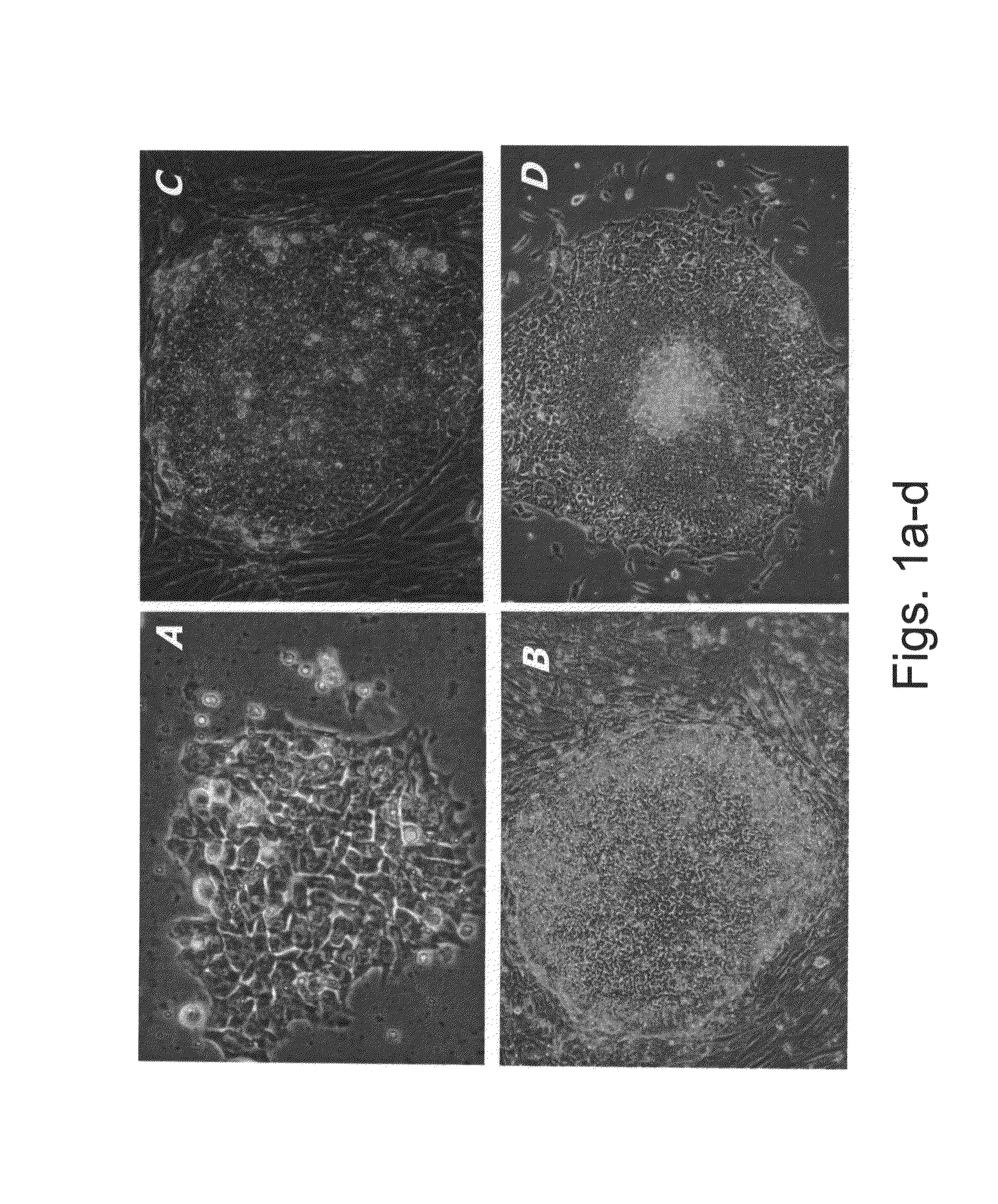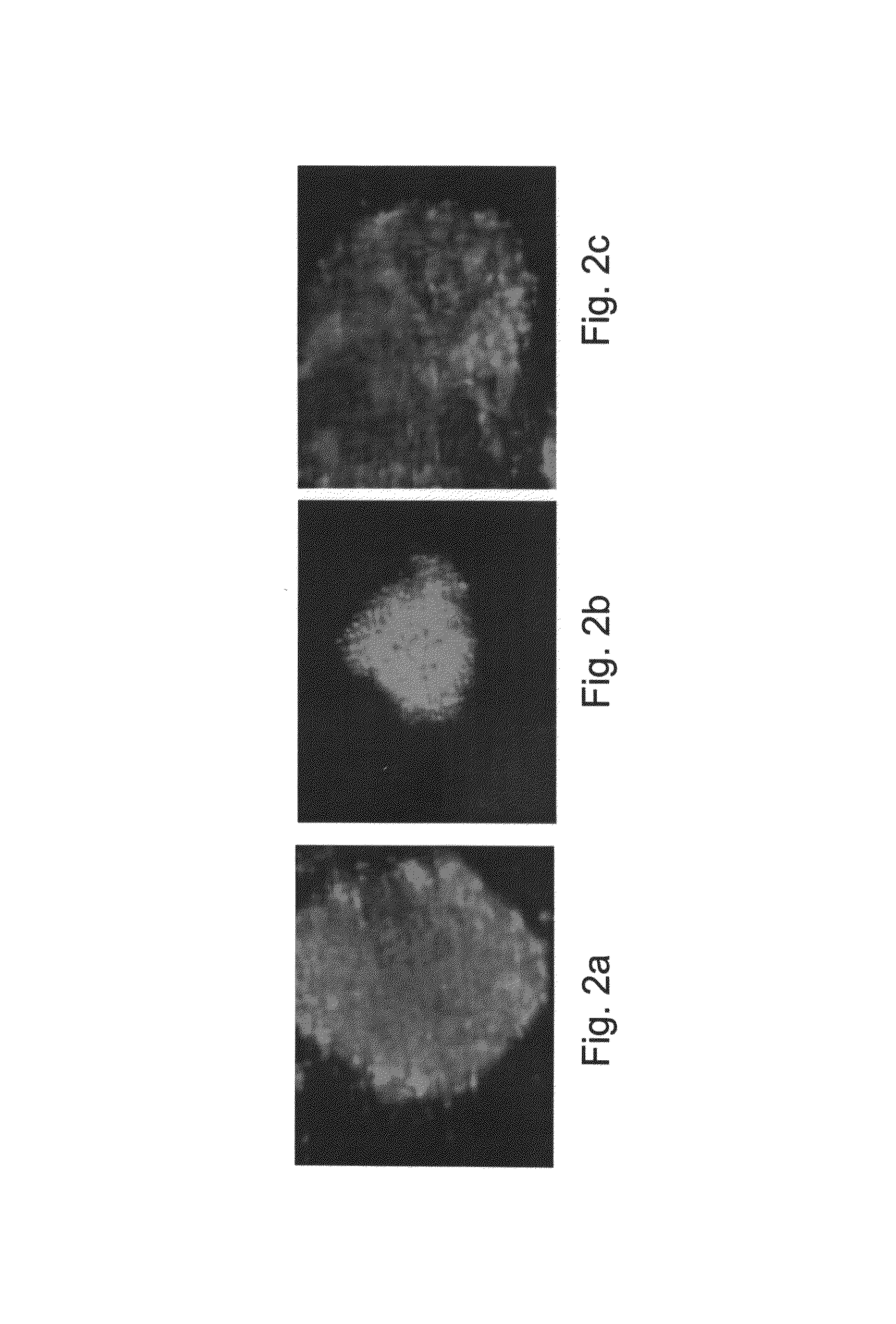Methods of expanding embryonic stem cells in a suspension culture
a technology of embryonic stem cells and suspension culture, which is applied in the field of expanding and maintaining embryonic stem cells, can solve the problems of limiting the expansion capacity of cells, limiting the robustness potential of such a culturing method, and not teaching non-dynamic suspension culture systems
- Summary
- Abstract
- Description
- Claims
- Application Information
AI Technical Summary
Benefits of technology
Problems solved by technology
Method used
Image
Examples
example 1
Culturing Human Embryonic Stem Cell on Feeder-Free Culture Systems with a Medium Containing TGF-Beta Isoforms and being Devoid of Serum, Serum Replacement and Albumin
[0223]Experimental Results
[0224]In this study the ability of few medium combinations, HA 16, HA 19, D1, D2, and CM100 to support undifferentiated and prolonged culture of hESCs in different culture conditions was examined. The basic medium, D1 or D2, is a commercial medium design for industrial and clinical proposes for the culture of hybridomas in suspension. The medium is free from animal, serum products and proteins. HA16 and HA19 are based on defined materials only. The CM100 medium contains the IL6RIL6 chimera and serum replacement.
[0225]The effect of two isoforms of TGFβ, TGFβ1 and TGFβ3, in supporting hESCs undifferentiated culture, was examined. Initially, two measures were used to estimate the ability of hESCs to grow in several culture systems, namely percentage of differentiation and rate of growth. The cultu...
example 2
The TGFβ-Containing or IL6RIL6-Containing Culture Medium are Capable of Supporting Culturing of hESCs in Cell Suspension
[0237]Since the new TGFβ-containing culture medium which is described in Example 1, hereinabove, is designed for massive cell culture (low protein content), suitable for industrial and clinical proposes cell production, the ability of D1, D2, HA19 and HA16 media to support suspension culture of undifferentiated hESCs was examined. In addition, the ability of a medium containing the IL6RIL6 chimera, such as the CM100F or HACM100 medium (as described in the General Materials and Experimental Methods) to support a suspension culture of hESCs was also examined. It should be noted that while the CM100F medium contains serum replacement, the HACM100 medium is serum or serum replacement-free and thus presents a well-defined culture, xeno-free culture medium.
[0238]Experimental Results
[0239]The CM100F, HA16, D1, D2 and HA19 media are suitable for culturing hESCs in suspensi...
example 3
Prolonged Culturing of Pluripotent, Undifferentiated Human ES Cells in Suspension in the Presence of the IL6RIL6 Chimera
[0259]Materials and Experimental Methods
[0260]hESC Cultures
[0261]hESC lines I-3, I-4 and I-6 [Amit & Itskovitz-Eldor, 2002] were cultured with inactivated MEF for 54-89 passages as previously described [Amit et al, 2000]. The following culture medium combinations were tested for their ability to support the suspended culture of hESCs:
[0262]Basic culture medium—consisting of 85% DMEM / F12 (Biological Industries, Biet Haemek, Israel), containing 15% knockout serum replacement (SR), 2 mM L-glutamine, 0.1 mM β-mercaptoethanol, 1% non-essential amino acid stock, and 4 ng / ml bFGF (all but mentioned are Invitrogen Corporation products, Grand Island N.Y., USA). This basic culture medium was used for the routine culture of hESCs in 2D culture with MEFs as control.
[0263]CM100F medium—consisting of the basic culture medium supplemented with 100 ng / ml IL6RIL6 chimera [Chebath J...
PUM
| Property | Measurement | Unit |
|---|---|---|
| concentration | aaaaa | aaaaa |
| concentration | aaaaa | aaaaa |
| concentration | aaaaa | aaaaa |
Abstract
Description
Claims
Application Information
 Login to View More
Login to View More - R&D
- Intellectual Property
- Life Sciences
- Materials
- Tech Scout
- Unparalleled Data Quality
- Higher Quality Content
- 60% Fewer Hallucinations
Browse by: Latest US Patents, China's latest patents, Technical Efficacy Thesaurus, Application Domain, Technology Topic, Popular Technical Reports.
© 2025 PatSnap. All rights reserved.Legal|Privacy policy|Modern Slavery Act Transparency Statement|Sitemap|About US| Contact US: help@patsnap.com



